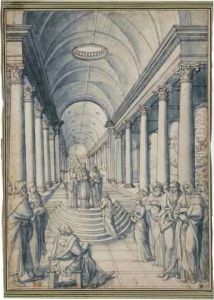Cornelis Ii De Vriendt Paintings
Cornelis II de Vriendt, often recognized for his contributions to the world of Flemish sculpture during the late Renaissance and early Baroque periods, was born in 1568 in Antwerp, a city that was then part of the Spanish Netherlands. His family was deeply entrenched in the arts; his father, Cornelis I de Vriendt, was a noted sculptor as well, establishing a creative lineage that Cornelis II would continue and expand upon. This period in European art was marked by a significant transition, blending the ornate and complex details of the Renaissance with the emerging dynamism and emotion of the Baroque. De Vriendt's work exemplified this shift, capturing the tension between these two influential artistic movements.
De Vriendt's education and early career were deeply influenced by the vibrant artistic community in Antwerp, a city renowned for its contributions to the Northern Renaissance. Under the tutelage of his father and amidst the city's flourishing art scene, Cornelis II honed his skills, embracing both traditional techniques and the new stylistic currents that flowed through Europe. His work, primarily in sculpture, was characterized by a meticulous attention to detail and a profound grasp of human anatomy, attributes that were highly prized in the artistic circles of his time.
Throughout his career, Cornelis II de Vriendt worked on various significant projects, including religious commissions and decorative sculptures for civic buildings. His ability to blend the spiritual with the corporeal, the timeless with the contemporary, made his works particularly resonant with patrons and the public alike. Despite the challenges of his era, including religious upheaval and socio-political changes as the Eighty Years' War unfolded, de Vriendt's art remained a beacon of the enduring power of humanistic and classical ideals.
Cornelis II de Vriendt's legacy, though perhaps not as widely recognized as that of some of his contemporaries, is significant for its contribution to the transitional period of European art. His sculptures not only reflect the complex interplay of Renaissance grace and Baroque energy but also serve as a testament to the rich artistic heritage of the Southern Netherlands. De Vriendt died in 1617, leaving behind a body of work that continues to be studied and admired for its craftsmanship and historical value. Through his sculptures, Cornelis II de Vriendt carved a niche for himself in the annals of art history, bridging two pivotal eras with his vision and skill.
